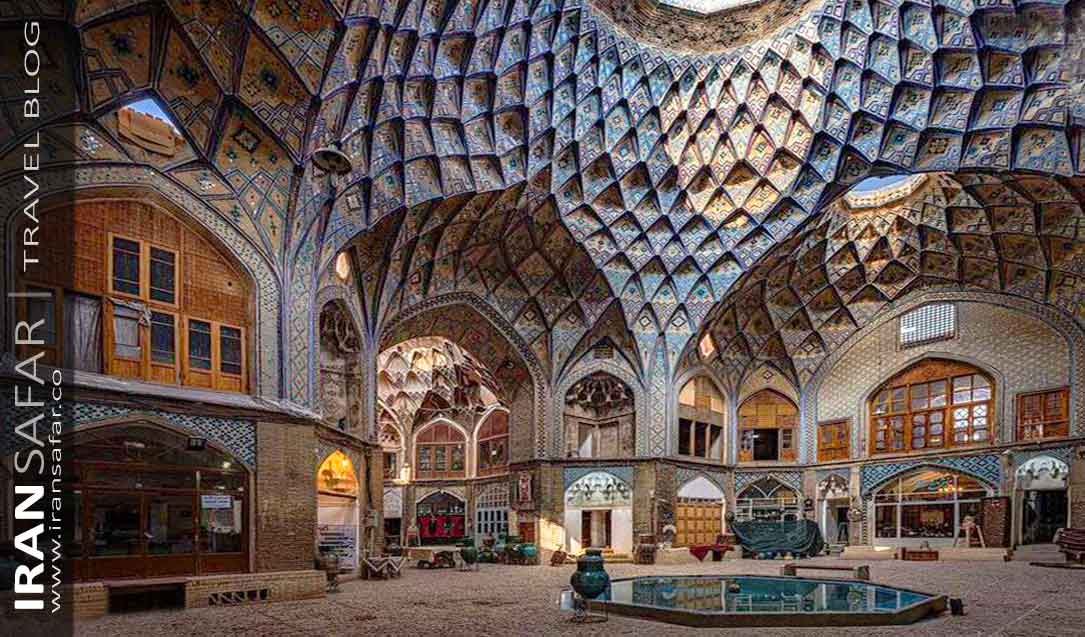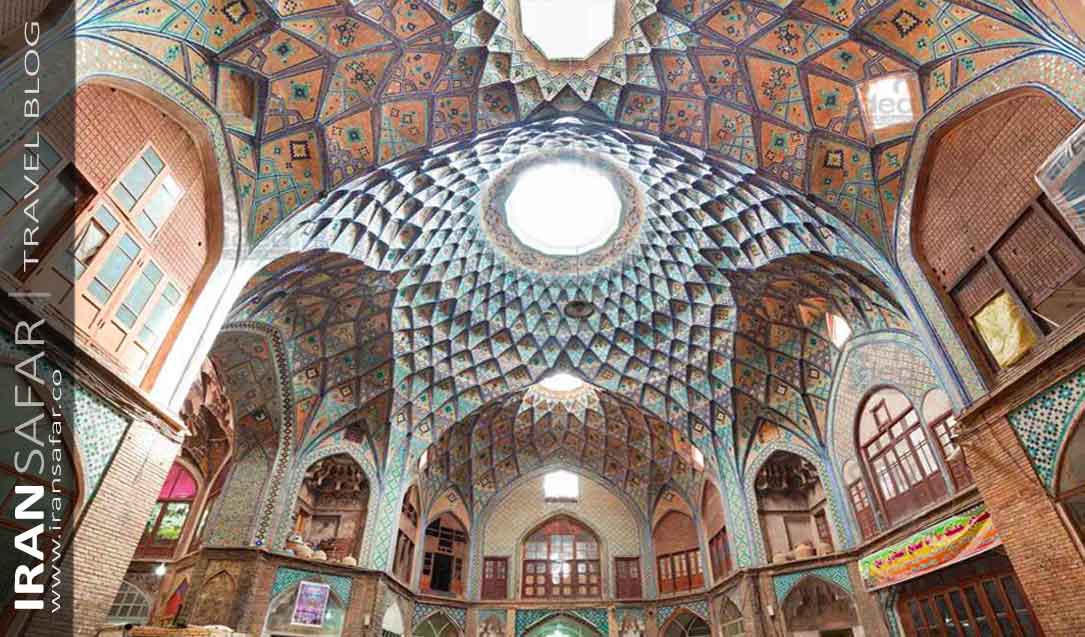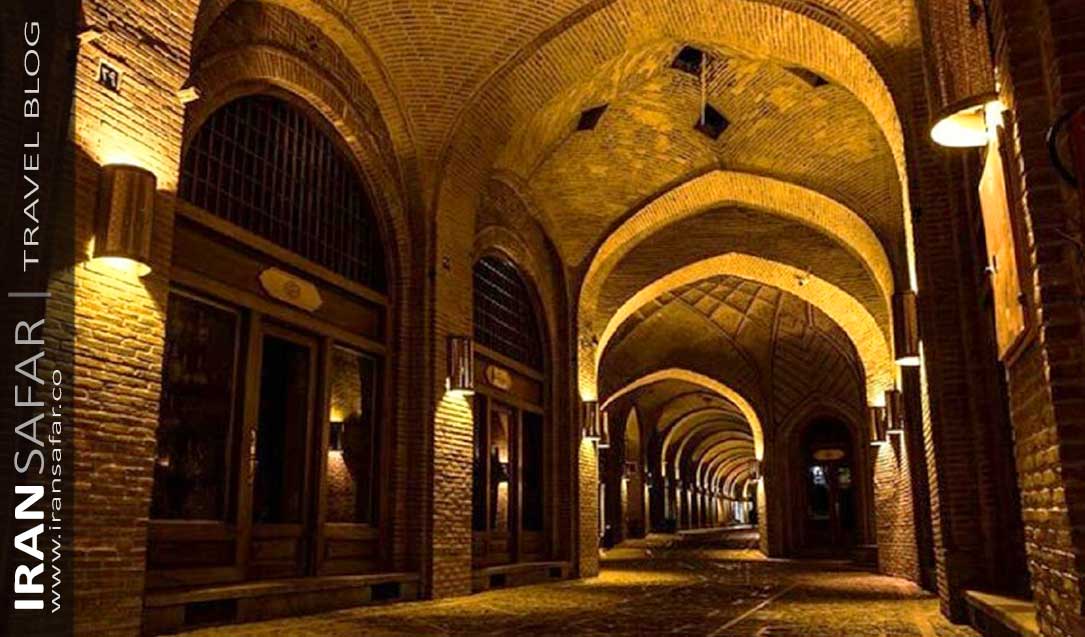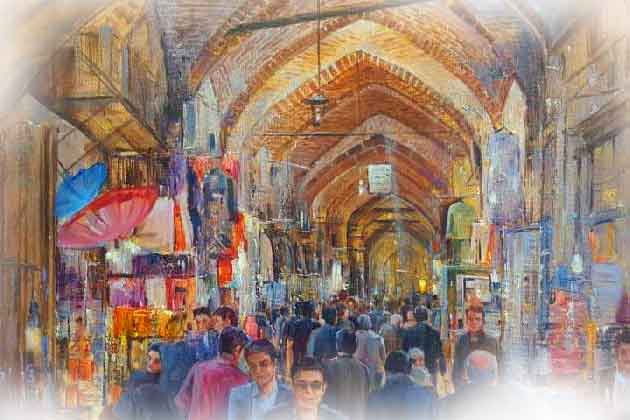Throughout the history of Iran – until not so distant past – Bazaars were considered of the most important social and commercial centers. Many important political and social developments started from the bazaars of Iran and spread to the rest of the society. This type of traditional market was the platform for most social communication and people not only found it as a place to trade and buy goods, but as a place to catch firsthand news and talk about events and social communication. For this reason, bazaars in Iran had a high value among the people.
What is a Bazaar?
Bazaars are still very popular shopping places especially for tourists in the Middle East, Turkey, the Balkans, North Africa and South Asia. The ones in the Middle East are traditionally roofed or located in vaulted or covered streets that had entrance and exit on each end and served as a central marketplace. However, temporary open markets elsewhere, such as in the West, might also designate themselves as bazaars. The term souk comes from Arabic and refers to the same concept in Arab states of the Middle East.
Bazaar is a Farsi (Persian) term for a traditional market consisting of rows of small shops or stalls. It referred to a town’s public market area.
Elements of the Iranian Bazaars
Bazaars are considered of the most important cultural and architectural structures of most middle-eastern countries. Their physical spaces and elements are also made up of different parts, each of which has a specific name and use.
In addition to commercial functions, the markets of Islamic cities have also played a very important role in social, political and religious aspects. When visiting an Iranian traditional bazaar, you can learn more about the culture of Iran, history and people’s lifestyle. In these markets, each section is usually dedicated to a profession.
1
Stall
The shop or stall is the most important and at the same time the simplest and smallest element and space of the bazaar. A number of stalls line up on both sides of the passage to form a market row.
The stalls on the ground floor have the role of shops and supply of goods, and the ones located on the upper floor have been used as two-story markets, offices and administrative spaces, and sometimes as workshops. Some of the stalls played the role of a workshop and at the same time the supply of goods.
2
Timcheh
Timcheh is a large and covered square-like space in the middle of Iranian bazaars. It is often built with an octagonal plan, and there is a two to three-story shopping space around it. These spaces are also surrounded by shops or commercial offices. The central space of Timcheh is usually roofed with a vault or a dome, and it is also decorated with eye-catching tiles and muqarnas.

Timcheh is usually the commercial office center for some first class merchants of a bazaar and the ground floor shops sell some specific and lux products such as hand-woven carpets, gold or handicrafts. Due to the importance of Timcheh areas of the traditional bazaars, they are usually renovated regularly and decorations are less old than other elements of the bazaar.
3
Caravanserai
As traffic along the Silk Road increased, so did the construction of caravanserais. In the past, there were two types of caravnserais :
En-route Caravanserai: They were built on caravan routes and were needed as safe havens—not just for sleeping overnight or escaping from extreme weather, but also from bandits who targeted caravans carrying silk, spices, and other valuable goods.
City Caravanserai: These structures were sometimes constructed in the middle of main bazaars of each city in order to accommodate the travelling merchants. These caravanserais played a great role in commercial exchanges. They were considered the distribution center and wholesale section for most imported products and also the place of interaction and exchange of cultures, beliefs and traditions.
Also Read – Famous Caravanserais of Iran
4
Chaar-Souk
In Chaharsu or Chaar Souk, the two main lines of the bazaar met and were interrupted by a large space. Chaharu were like today’s street intersections in the middle of the market! Among the good examples of Chaharsu, we can mention the large Chaharsu of Isfahan bazzar and the Chaharsu of Tehran and Kerman bazaars.
5
Service areas
In every permanent and main bazaar, there have been a number of service spaces such as water storage, stables, public storage, toilets and Persian Hammam. The number of these spaces, their location along the market depends on the characteristics of the market.
6
Mosque
Usually, there are mosques at the end of each Bazaae and these mosques are part of the attraction of the markets. Sometimes old schools are also located at the heart of a bazaar.
Top 7 Bazaars in Iran
In almost all Iranian old cities, you can find traditional marketplaces that are usually old. The beautiful and unique architecture of these bazaars has made them one of the important tourist attractions of Iran. Most of the bazaars are gathered in the cities located in the center and west regions of Iran.
Bazaar of Tabriz
When we talk about traditional Iranian Bazaars, the bazaar of Tabriz is the first place to remember. The best and most famous traditional market of Iran has settled in Tabriz. Where it is known as the largest roofed bazaar in the world.
For many centuries, the city of Tabriz was located on the route of the Silk Road, especially at a point that was considered the gateway to connect the East and the West. The importance of Tabriz bazaar was such that its gates were considered as the main gates of the city. There is not much historical information about the first foundation of the Tabriz bazzar, and therefore it is impossible to determine the exact date for the formation of this market.
Tabriz covered Bazaar, also known as Tabriz Grand Bazaar, is the largest covered market in the world and also considered the largest brick complex in the world. A market where you can buy goods such as hand-woven Persian carpets, leather products, Persian spices , nuts, fabrics, handicrafts and enjoy watching its unique architecture.
Tabriz bazaar is built in a complex with an area of about one square kilometer. This market has 11 corridors, 20 rows, 25 timchehs, 35 houses and 6500 shops and stalls. Think about it! The number of shops and people who visit this market every day is very impressive and interesting.
Tabriz grand bazaar has been registered as a UNESCO World Heritage.
Grand Bazaar of Isfahan
Qeysarie Bazaar or Grand Bazaar of Isfahan is the most famous traditional market in Isfahan . This beautiful market is located in Naqsh-e Jahan square. At the head of the entrance to the Qeysarie Bazaar, there are remains of beautiful tiling decorations with paintings from Safavid era (17th century).
In case you enter the Qeysarie Bazaar from Naqsh-e Jahan you will reache the famous 1000 year-old Jame Mosque (Friday mosque) after a 20-min walk. You can see interesting buildings along the bazaar that are left from different historical periods. Tousands of shops, old timchehs, caravansaries and handicrafts made by the best artists of Isfahan, are among the attractions of Qeysarie.
Bazaar of Kashan
Iranian Bazaars are so beautiful that it is really difficult to name any of them as the most beautiful one. Kashani people consider the Bazaar of Kashan as the heart of the city; a local market that was famous for its copper shops in the old days, and some of them still remain strong. In fact, the fame of this bazaar is due to its copper sellers, Kashan sweets, handicrafts and carpets.
The beautiful architecture of this bazaar and the existence of a caravansary, timchehs, and beautiful buildings along it have made us give this attribute to this traditional bazaar dating back to the Safavid period (17th century).
An important feature of Kashan bazaar is its location in a busy and historical area. Famous attractions such as Boroujerdi mansion and Taba Taba’i house are located nearby.
 Amin Al-Doleh Timcheh, Kashan Bazaar, Iran
Amin Al-Doleh Timcheh, Kashan Bazaar, Iran
Amin Al-doleh Timcheh or caravanserai is one of the architectural and historical buildings related to the Qajar period and it is located in the bazaar of Kashan and this work was registered as one of the national works of Iran.
Yazd Bazaar
The City of Yazd is located in the central deserts of Iran. It is a living testimony to intelligent use of limited available resources in the desert for survival. Buildings are built of earth and water is brought to the city by underground water systems called Persian Qanat. Each neighborhood of the city has its own qanat and a communal center. In modern days, the city escaped the modernization trends that destroyed many traditional earthen cities. It survives today with its traditional districts, the qanat system, traditional houses, mosques, bazaars, hammams, water cisterns and The city enjoys the peaceful coexistence of three religions: Islam, Judaism and Zoroastrianism.
Due to its long history, Yazd is one of those cities that has many traditional bazaars. If you like traditional and historical markets, Yazd is your heaven. The old bazaar of Yazd consists of different sections: Khan Bazaar, Panjeh-Ali, Qeysarie, Zargari, Alagbandi, Mullah Ismail, Chitsaz-ha, Darwazeh Mehriz, Sadri, Afshar and Mesgari are among the traditional markets of Yazd.
Bazaar of Qazvin
It might be interesting to know that Qazvin Bazaar is one of the oldest markets in Iran. The traditional bazaar of Qazvin dates back to about a thousand years ago, though, the current building was completed during the Safavid and Qajar periods.
After Qazvin was chosen as the capital of Iran during the Safavid period, a large square was built in Qazvin, which became the main platform of its bazaar. This square later became a model for the construction of Naqsh-e Jahan square in Isfahan.

The most beautiful part of Qazvin bazaar, which shouldn’t be missed, is the Sa’ad al-Saltaneh caravanserai and passage. The tiles and the outstanding architecture of this place will amaze every viewer. There have been recently fancy boutiques selling leather, gold, and handicraft products in this bazaar passage.
Old Bazaar of Qom
Do you want to get to know a corner of old Qom? Step into its old alleys and pass through the narrow roofed passages flanked with shops and stalls? If yes, you should go to the old Bazaar of Qom.
Qom is considered the second religious tourism destination of Iran due to the shrine of Fatima Masouma , and every year thousands of travelers enter this city to visit this holy place.
The old bazaar of Qom has two covered passages. There are several mosques, chaar-souks and several mosques along the market. Timche of this market was built by an architect named Mimar Bashi around 1927.
In this old market, you can find things that are not found anywhere in the city. Kohneh-Bazaar of Qom was mostly left from the Safavid era and is not very life-full, but there are still those who have not abandoned the old business and their shops are still standing.
For example, here you can find perfume shops, fruit shops, coppersmiths and carpentry shops and touch a corner of the past.
Tehran Grand Bazaar
Tehran Bazaar, like any other Iranian old traditional markets, is a series of winding corridors, archways, and domes, each of which built with great care. It is true that this market has seen many changes over time, but its old parts are still standing and have many beauties.
In Sir Thomas Herbert‘s travelogue, there is a description of the Tehran bazaar in 17th century (during the Safavid rule over Iran) which Herbert described as an open market. This explains that there has been a grand bazaar in Tehran since about 400 years ago.
But it was during the rule of Naser al-Din Shah Qajar (19th C) that the main entrance and roofed corridors were built and even other constructions such as mosques and Timches were organized during this period. Today, the name of Tehran’s Grand Bazaar is in the list of national heritage of Iran since 1977.
Also Read – Tehran Travel Gudie



Comment (0)